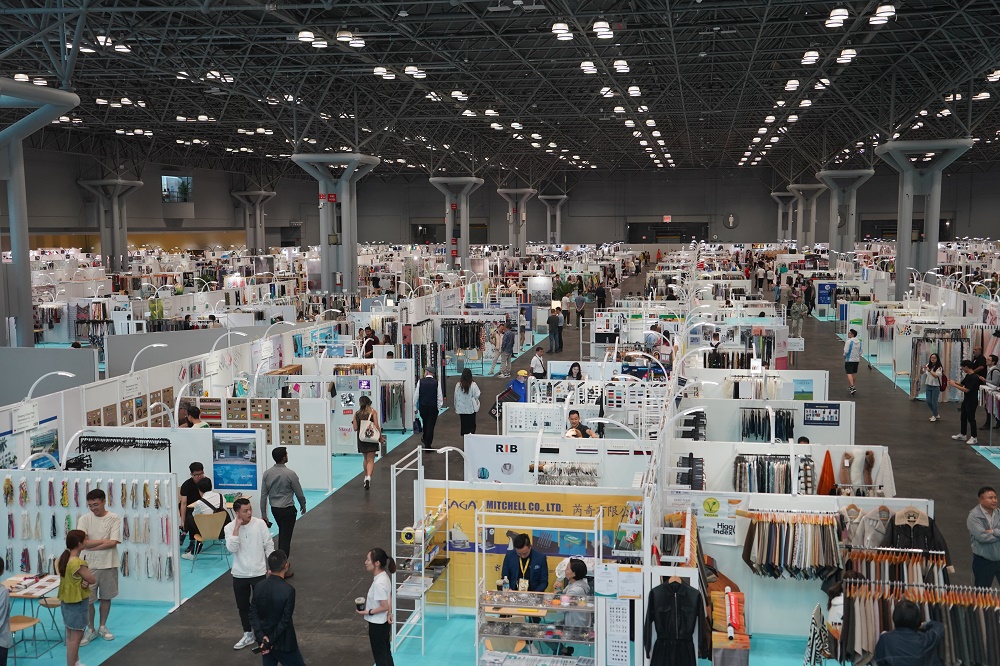Chinese textile exporters strive for post-pandemic comeback
By MINLU ZHANG in New York | China Daily Global | Updated: 2023-07-19 10:06

As she placed small Chinese and American flags in front of the camera, Sina Lee, a fabric manufacturer from Guangdong province, conducted a live sales broadcast at a New York trade fair on her phone. Meanwhile, Lee's husband enticed customers.
This year, following the pandemic, an increasing number of Chinese textile exporters, like Lee, are returning to the international market.
The 24th China Textile and Apparel Trade Show, which runs for three days, opened Tuesday at the Javits Center in New York. The exhibit is a platform for the latest industrial trends and for Chinese companies exploring the US market.
The China show is part of Texworld, the largest show ever held at the sprawling convention center in Manhattan, with approximately 1,000 companies participating — 80 percent from China.
China has the world's largest and most complete textile industry chain. It is also the largest producer, exporter and consumer of textiles, said Huang Ping, Chinese consul general in New York, at the fair's opening ceremony.
China's highly market-oriented textile industry is deeply integrated into the global supply and value chains of the sector, he said.
"The threads and the needles connect both sides of the Pacific and represent the inseparable economic ties between China and the US. Moreover, they weave the fabric of friendship between the two peoples," Huang said.
"It is difficult for any country to completely replace China's huge market and strength in the industry. The US knows as well, as for China, no single country could demand and consume as many textiles as the US does. Such interdependence and complementarity between the two countries call for a long-term, stable, cooperative relationship," Huang said.
Huang visited a dozen booths at the fair. At Ningbo Mondiland Fashion booth, Huang tried on a suit made with a new warp-knitting method.
"Your clothes are very beautiful. You should export more to the US market since the demand here is quite large," Huang said to the company's representatives. "The clothes made in China have no wrinkles," said the ambassador, looking at the sleeves after trying on the suit.
Liu Zhibo, the vice-chairman of the Haiyang city sweater association, met Huang at the fair and said Haiyang city, located in Shandong province, is home to approximately 100,000 sweater workers and around 6,000 merchants.
With an annual export of more than 20 million pieces of clothing, the sweater industry is the pillar of Haiyang's economy, Liu said.
Many companies in Haiyang have never been to the US market before, and they all turned out to participate in this year's exhibition, said Liu, who is also the chairman of Rosa Blu Textile.
Rosa Blu, which has received orders from Japan and South Korea markets, has developed a style specifically tailored for the American market. It employs a woollike material with special fibers that make the finished garments lightweight, Liu said.
Huang also visited Yantai North Home Textile, a company specializing in making bedding fabrics for hotels. The North American market constitutes around 50 percent of sales for the company, which has an annual export volume of approximately $100 million.
Over the past few years, the world has undergone profound changes, and China-US relations have encountered significant challenges, Huang said. However, certain aspects remain unchanged: Economic and trade cooperation between China and the US is mutually beneficial, and the two countries are highly complementary and interdependent, he said.
"I hope both countries can seize opportunities and strengthen cooperation and contribute to a healthy, stable and sustainable growth of China and US economic and trade relations," he said.
In the aftermath of the pandemic, some Chinese foreign trade companies have been transformed. Some manufacturers have embraced online channels, using live broadcasts and social platforms to promote and receive orders.
"Over the past three years of the pandemic, live broadcasts and social media platforms have allowed us to reach a wider customer base, attracting startup buyers," Sina Lee, the founder of Gongguan Rainbow Touches Garment, told China Daily at the fair.
Rainbow Touches Garment is an export factory specializing in trendy men's clothing, operated by the Lee couple. With annual sales ranging from $5 million to $7 million, the company, which recently exhibited in Australia, is participating in the New York trade fair and has plans to showcase in Los Angeles next week.
























